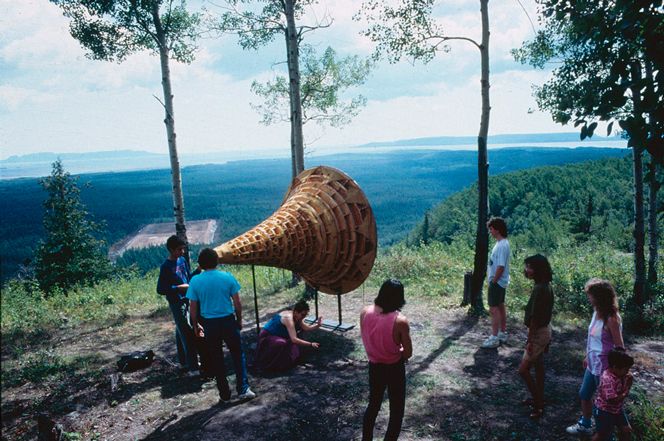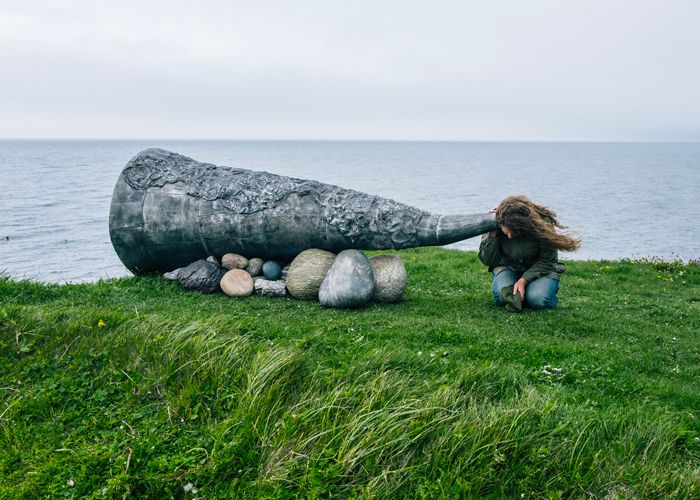Rebecca Belmore’s artwork is best known for the response it elicits in its viewers: speechlessness, contemplation, and empathy. Its evocative nature centering the pain of marginalized subjects and the importance of our connection to nature, Belmore uses her artwork to explore the relation of politics, beauty, and recognition.
Belmore is a member of the Lac Seul First Nation (Anishinaabe) and currently resides in Toronto, but her acclaim reaches far beyond Canadian borders. Belmore has been internationally recognized for her work highlighting marginalized voices. She received the Jack and Doris Shadbolt Foundation’s VIVA Award in 2004, an Honorary Doctorate from OCADU in 2005, the Hnatyshyn Visual Arts Award in 2009, the Governor General’s Award in Visual and Media Arts in 2013, and an Honorary Doctorate from Emily Carr in 2017. In 2005, she served as Canada’s official representative at the Venice Biennale.
The importance of Belmore’s artwork, including her mixed media and performance pieces, is centering voices that might not otherwise have been heard. Her work is directly connected to the United Nations Sustainable Development Goals for Climate Action and Life on Land.
In response to the 1990 Oka crisis, when the Canadian government violently repressed a Mohawk group protesting the development of their ceremonial and burial grounds into a golf course, Belmore created Ayum - ee- aawach Oomama- mowan: Speaking to their Mother. The giant megaphone was first used in a meadow in Banff National Park, where Belmore asked visitors to shout through it to speak to Earth, their “first mother” and the spirit of the water. Their voices echoed back nine times. Throughout 1992, Belmore toured her work through sites where Indigenous land claims were being asserted to demand justice, and subsequent gatherings took place across Canada in 1996, 2008, and 2014.

Similarly, Belmore’s Wave Sound sculptures encourage visitors to pause and listen carefully to the sounds of the land around them. These four sculptures vary in shape to best respond to each natural site, placed in Banff National Park, Pukaskwa National Park, Georgian Bay Islands National Park, and Gros Morne National Park. In amplifying the sounds of the landscape, these sculptures spark a contemplation of our relationship with the land around us.

Belmore’s artwork also has a direct connection to the United Nations Sustainable Development Goals for Gender Equality and Reduced Inequalities. Her work entitled Fringe was displayed in Vancouver and Montreal on large billboards, forcing viewers to confront the systemic violence inflicted on Indigenous women — even in settings such as a hospital, meant to be a place for healing.
The subject is an Indigenous woman with a large scar covering her whole back, with the trickles of blood made in beads to reference traditional Indigenous craftsmanship. The use of beads is also reminiscent of the 1980 incident at St Boniface hospital, when a surgeon sewed beads into the wound of an Indigenous female patient after a major surgery. The patient reported feeling humiliated, as hospital staff laughed at her condition, not telling her about the beads until weeks after the surgery. In conversation with the Vancouver Art Gallery, Belmore stated that the wound in this artwork is on the mend. It represents the pain inflicted by the world onto Indigenous women, but more importantly the resilience of the subject to heal despite her lifelong scar.
In her performance piece Creation or Death: We Will Win, Belmore bound her hands and body and moved a pile of dirt up a set of stairs in a frenzied state. Dirt escapes Belmore’s hands at every step. The piece is meant to immerse the viewers in the everyday struggle of Indigenous people to reclaim their land and culture. Belmore’s frustration and difficulty is palpable, but so is her determination. Her performance highlights not only the ongoing movement to reclaim territory, but also the emotional component that accompanies a drawn-out loss of culture, land, and identity.
Belmore’s work highlights the importance of listening to marginalized voices, or subjects without a voice, including the earth and our natural surroundings. She encourages people to rethink their interaction with the earth, especially in the context of the pandemic. The economic shutdown allowed the environment a break, a moment of freedom from constant human intervention.
In an interview with Wanda Nanibush of the Art Gallery of Ontario, Belmore said, “We’re living in these difficult times, and we have to rethink our lives … with the current shutdown of the economy due to the coronavirus pandemic, we have a glimpse of the potential for change and for some kind of more equitable, sane way of living.”
Learn more about Rebecca Belmore and her lifelong work on her website.
